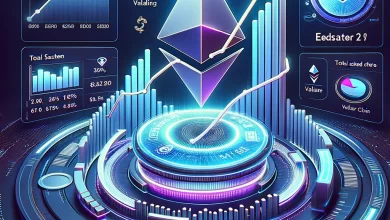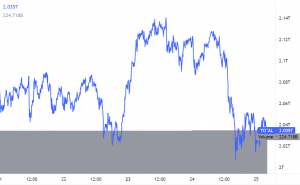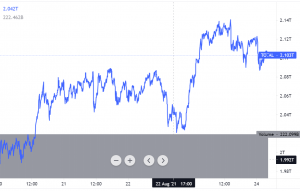Multi-Collateral DAI: Collateral Priority Race Begins
This article was written by Dmitry Bondar, a monetary theorist, cryptocurrency researcher and author of Stablecoins: From Electronic Money on Blockchain to a Cryptocurrency Basket exclusively for forklog.media. Views and opinions expressed herein are solely those of the author and do not necessarily reflect the views and opinions of the forklog.media editorial board.
DAI is the biggest decentralized stablecoin out there. MakerDAO accounts for over 60% of the total value locked in DeFi. Moving from Single-Collateral Dai (SAI) to Multi-Collateral Dai (MCD or DAI) in late 2019, two years after the launch of MakerDAO, was the most important milestone in this stablecoin’s history.
Moving from SAI to DAI means that now DAI can be issued not just with wrapped ETH as collateral, but also with other ERC-20 tokens on Ethereum blockchain. The idea is that the diversification of the collateral portfolio would make DAI more reliable. The Maker team stressed that later on, with MKR (MakerDAO’s governance tokens) holders approval, any tokenized asset with acceptable risk parameters may be added to DAI’s collateral portfolio.
Acceptable risk parameters for DAI collaterals, however, are not defined. Nobody discusses which risk parameters should exclude ETH or another token from DAI’s collateral portfolio. Still, there has been the first experience of choosing new collaterals for DAI, and that’s the topic of this article.
Choosing New Collaterals
The Maker forum lists over ten new collaterals for DAI, including Uniswap Liquidity Tokens and fiat-backed stablecoins. Still, only 6+1 tokens were featured in the MKR holders’ vote held from 12 to 19 August 2019: OmiseGO (OMG), Golem (GNT), Augur (REP), DigixDAO (DGD), Basic Attention Token (BAT), 0x (ZRX), and Ethereum (ETH).
The votes were cast as follows.
Distribution of votes between tokens featured in MKR holders’ vote. Data: MakerDAO
Shortly before the launch of MCD, on 9 November 2019, Maker Foundation’s Head of Backend Services Niklas Kunkel mentioned all the contenders from that list except GNT in MakerDAO’s Telegram chat:
“Dev here: BAT will be included at launch. ZRX, REP, OMG, and DGD are being looked at for being added shortly after.”
Finally, the post on the MCD launch dated 18 November 2019 mentions only two ERC-20 tokens:
“The collateral types offered in MCD currently are ETH and BAT, Brave’s digital advertising token. The Maker community is currently evaluating an additional token—prediction market Augur’s REP.”
Even though REP garnered more votes from MKR holders, BAT is currently the only addition to ETH. The post above does not offer any explanation to this change of priorities contrary to the results of the vote. Still, it should be noted that the Micah Zoltu argument against REP is one of the most active discussions on the Maker forum’s section on collaterals.
The Problem of Deleveraging Spirals
In their research of deleveraging spirals that decentralized stablecoins like DAI are prone to, Ariah Klages-Mundt and Andreea Minca discovered stable and unstable domains in such coins. Unstable domains in their model exist even with the steady price of ETH as collateral. They add:
“Note that feedback of large liquidations on Ether price, if added to the model, will make the unstable domain even larger.”
Is DAI backed with a portfolio of ETH, BAT, and REP that had won the collateral priority vote more reliable than SAI? I chose two criteria for the initial assessment. Firstly, the stability of BAT and REP prices, how they react to ETH deprecation, and how volatile they are. Secondly, the liquidity of BAT and REP against ETH, or how good they withstand large liquidations.
First Criterion: Correlation with ETH and Volatility
Diversifying DAI’s collateral portfolio to increase the system’s resistance against ETH deprecation is complicated by the fact that ETH has become the highest correlated crypto-asset in 2019. Binance Research’s 2019 Annual Crypto-Correlations Review claims that crypto-assets continue to be highly correlated with each other, and this correlation may increase during adverse price movements.
BAT and REP have a positive correlation with ETH over 0.5.
BAT and REP correlation with ETH. Source: Coinmetrics
BAT and REP are more volatile than ETH, even though their volatility has become much lower since early 2019.
BAT, ETH, and REP volatility. Source: Coinmetrics
This positive correlation with ETH and volatility higher than ETH’s mean that BAT and REP don’t make DAI more reliable than SAI by our first criterion. When the ETH price drops, BAT and REP drop as well but to a greater degree.
Second Criterion: Liquidity
To compare the liquidity of ETH, BAT, and REP we used historical data from Coinpaprika about their market depth measured as a 10% section of the order book from the midpoint price. Here, we are interested in the possibility of mass sales of collaterals, so we look not on the sum of the bid and ask orders but only on bid orders.
ETH’s liquidity has grown since the beginning of 2020 by 60%, from $104m to $166m. ETH liquidity. Source: coinpaprika
ETH liquidity. Source: coinpaprika
BAT’s liquidity has grown since the beginning of 2020 by 60% as well, from $2m to $3.2m. BAT liquidity. Source: coinpaprika
BAT liquidity. Source: coinpaprika
Each collateral asset in Maker has a debt ceiling, which is the issuance limit for DAI collateralized by the asset. For that reason, we can use the liquidity/debt ceiling ratio to estimate the balancedness of DAI’s collateral portfolio.
As an example, let’s take the data on liquidity and debt ceiling for ETH and BAT on February 9, 2020.
Liquidity and debt ceiling for ETH and BAT on February 9, 2020. Data: coinpaprika, Dai Stats
Thus, even though ETH’s liquidity was 52.48 times as high as BAT’s, the mass sales resistance coefficient for ETH was only 1.25 times higher than that of BAT.
BAT’s liquidity in the second half of 2019 fluctuated between $2m and $3m, so its liquidity/debt ceiling ratio was very seldom below 0.67 or above 1. ETH’s liquidity during the same time fluctuated between $90m and $140m, and the liquidity/debt ceiling ratio wandered between 0.72 and 1.12.
As BAT’s liquidity/debt ceiling ratio is lower than ETH’s, the current version of DAI is not more reliable than SAI by our second criterion as well.
REP has not been added to DAI’s collateral portfolio, and its debt ceiling is not established. But I can assume it will be lower than BAT’s as REP is less liquid. REP liquidity. Source: coinpaprika
REP liquidity. Source: coinpaprika
REP’s liquidity in the second half of 2019 has been six-digits almost all the time, yet it started growing in early 2020 and reached $1.283m by February 9. If we assume that the liquidity/debt ceiling ratio should be more or less the same for all DAI collaterals, REP cannot reach for a debt ceiling over $1m.
When estimating DAI collaterals’ resistance against mass sales one may also consider the sensitivity of the collateral’s liquidity to its deprecation (as they are sold only when prices drop). The price and liquidity charts for ETH, BAT, and REP show positive correlation: deprecation is accompanied by a drop in liquidity.
What’s Next?
Now it’s time to join the collateral priority race. The primary estimation by the criteria of price stability and liquidity doesn’t provide much grounds to consider DAI backed by ETH, BAT, and REP more reliable than SAI. It’s more likely the other way round.
If you don’t like those conclusions, you probably won’t like the fact that MKR as the collateral of last resort for DAI is not very much different from BAT and REP in terms of correlation with ETH, volatility, and liquidity. Moreover, MKR as the collateral of last resort doesn’t have a debt ceiling by definition.
DAI positions as a decentralized stablecoin. A decentralized stablecoin requires decentralized collateral, i.e. native tokens of public permissionless blockchains and DApps running on such blockchains. The problem is that such tokens have a pronounced positive correlation that may increase during unfavorable price movements as well as high volatility and low liquidity. This complicates the diversification of DAI collateral portfolio and brings to mind ERC-20 tokens backed by traditional assets controlled by a custodian. This, in turn, raises the question of how important it is for a stablecoin to remain decentralized.
Rune Christensen has seen the potential solution to the real-world collateral controversy in keeping SAI under the name PurityDai. The idea was for MakerDAO to issue not one but two stablecoins: SAI backed solely by ETH, and DAI backed by a collateral portfolio that includes traditional assets. In particular, Christensen noted:
“What’s really cool about this approach is that PurityDai would be a very unique asset in that it would have both the benefit of being backed only by ETH, and thus have no chance of having its collateral seized, but it would actually still also be protected against black swan events in the price of ETH because it would share the same MKR with Dai and other synthetic assets, and thus would still benefit from the highly diversified black swan protection that real-world assets offer.”
In the case of Single-Collateral Dai, the liquidity of MKR as the collateral of last resort should be sufficient for black swan events in the price of ETH. The current version of Multi-Collateral Dai, the liquidity of MKR should be sufficient for two collaterals at once, ETH and BAT. The question of how the MKR liquidity would change as there is more supply of MakerDAO’s synthetic assets and more collaterals are added remains to be answered.
Still, whatever the community comes to in the dispute about potential collaterals for DAI, the decisions on adding new collaterals and their debt ceiling will be made by pseudonymous MKR holders that have no obligation to publicly justify their choice.
Follow us on Twitter and Facebook and join our Telegram channel to know what’s up with crypto and why it’s important.
Source: forklog.media
View original post








